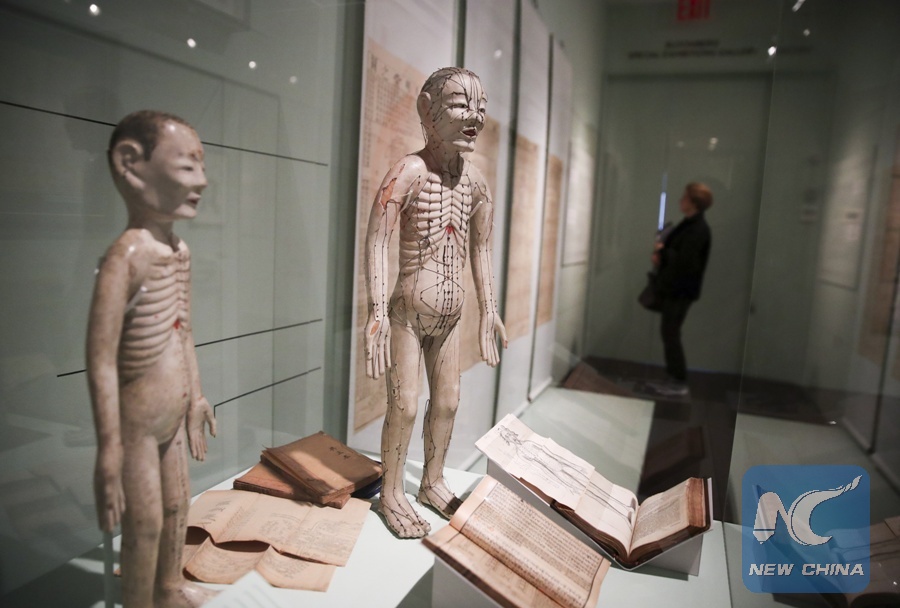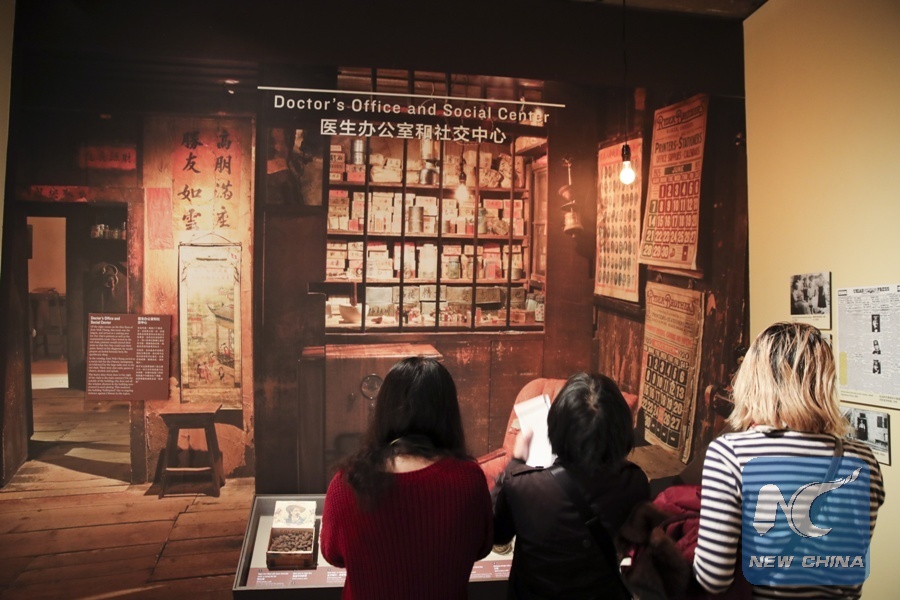
A visitor looks at exhibits during the press preview of Chinese Medicine in America: Converging Ideas, People and Practices and On the Shelves of Kam Wah Chung & Co. in the Museum of Chinese in America in New York, the United States, April 25, 2018. (Xinhua/Wang Ying)
By Xinhua writer Yang Shilong
NEW YORK, April 27 (Xinhua) -- Traditional Chinese Medicine (TCM) has traveled a difficult road toward legitimacy and integration in the United States, reflective of many aspects of the Chinese immigrant experience.
This is why the Museum of Chinese in America (MOCA) in New York City puts on two groundbreaking exhibitions, which run from April 26 to Sept. 9, attempting to trace the complex story of Chinese medicine in the country.
"Chinese Medicine in America: Converging Ideas, People and Practices" tells a cross-cultural story of Chinese medicine and practices in America through historical medical artifacts, contemporary art, and profiles on notable figures in Chinese medicine history to create an engaging space for exploring how medicine, philosophy and history are linked.
On the Shelves of Kam Wah Chung & Co.: General Store and Apothecary in John Day, Oregon, is an immersive historical exhibition that celebrates the medical practice of Ing "Doc" Hay who became a prominent figure in eastern Oregon after the California Gold Rush.

Journalists look at exhibits during the press preview of Chinese Medicine in America: Converging Ideas, People and Practices and On the Shelves of Kam Wah Chung & Co. in the Museum of Chinese in America in New York, the United States, April 25, 2018. (Xinhua/Wang Ying)
THROUGH LENS OF CHINESE MEDICINE
"I think it's important to celebrate the culture and history of the Chinese in America through the lens of Chinese medicine," Donna Mah, a faculty member of the Pacific College of Oriental Medicine in New York, told Xinhua at Wednesday's press preview.
"We have really worked hard to put together a prism to shine the light of Chinese medicine, and have Chinese culture and history sort of blasted in a beautiful rainbow on the wall," said Mah, guest curator of the exhibitions.
"By seeing how we treat illness and maintain our health, we hope visitors can learn about the ancient philosophical concepts that are the backbone of Chinese culture," said Herb Tam, MOCA's curator and director of exhibitions.
Only four states in America to date do not have legislation on professional practices of TCM. It has grown into an industry with 40,000 licensed therapists, and treats over 380 million patients every year.
Yet, until the 1970s, practising acupuncture in America could land you in jail.
This happened to Miriam Lee, an acupuncturist who treated patients in her Palo Alto, California home. She was arrested for practising medicine without a license in 1974, but many of her patients appeared at her trial to attest to the benefits of acupuncture.
Days later, Governor Ronald Reagan legalized acupuncture as an experimental procedure and 1976, it was officially legalized in the sunshine state.
Lee, who died in 2009 in Southern California where she lived after retirement, recorded her experiences in her 1992 book "Insights of a Senior Acupuncturist."

Herb Tam, Museum of Chinese in America (MOCA)'s Curator and Director of Exhibitions, introduces exhibits during the press preview of Chinese Medicine in America: Converging Ideas, People and Practices and On the Shelves of Kam Wah Chung & Co. in the Museum of Chinese in America in New York, the United States, April 25, 2018. (Xinhua/Wang Ying)
GLIMPSE INTO EARLY CHINESE IMMIGRANTS LIFE
Ing Hay, better known as Doc Hay, was the first documented acupuncturists and herbalists in the United States. Hay did "ku li" (a Chinese term meaning "muscle strength") work in the Walla Walla area before he moved to the mining town John Day, eastern Oregon, in 1887.
Hay met his life-long friend and business partner Lung On on the streets of John Day, a small town nestled in the higher elevations of the Blue Mountain range. They purchased the Kam Wah Chung & Company (literally, the "Golden Flower of Prosperity") building, which soon became the center of the Chinese immigrant community in John Day.
The number of Chinese in John Day at that time might have exceeded 2000 - mostly men - making it the third largest Chinatown in the United Sates then. It was a time the Chinese were openly treated as second-class citizens. As the railroads were built and the need for cheap muscle began to fade, the U.S. government slammed the door and started encouraging Chinese to leave.
By 1900, less than 100 Chinese remained. Patrons at Kam Wah Chung shifted from predominantly Chinese to mostly non-Chinese. Despite the prevailing anti-Chinese sentiment in the United States, the store not only survived, but flourished. This was due to the remarkable skills of its two proprietors.
Hay and On were both arrested several times for practising medicine without a license but due to their popularity in the community, each case brought against them was dismissed. All their patients survived the fatal Spanish Flu epidemic in 1919, according to an interesting side note.
CONVERSATION BETWEEN HERITAGES
"The Chinese-American population is a vital part in the making of this country. Unfortunately, it's been under-recognized," Nancy Yao Maasbach, MOCA's president, told Xinhua. "One of its (MOCA) main goals is to help people understand the contributions by Chinese in the formation of this country."
MOCA, which has about 50,000 visitors a year, aims to engage audiences in an on-going and historical dialogue, in which people of all backgrounds are able to see American history through a critical perspective, to reflect on their own experiences, and to make meaningful connections between the past and the present, the global and local, themselves and others, she said.
Mah noted the Chinese medicine exhibitions are exactly a good space for initiating conversations between cultures.
"I think the more that we have conversation, genuine conversation, genuine curiosity, interest, respect will all benefit," she said. "That reflects the benefit of having been of Chinese heritage living in America."
"Through the conversations you have realized that we share so much in common and we need to make it not only a local phenomenon, but a global phenomenon, finding the places we really can connect, learn and benefit one another," Mah said.
"You know, wondering who are we, what is our place in the world and how it relates to us and one of the ways that we can do so beautifully is through art of the landscape painting," said Mah. "The classical Chinese landscape paintings have big, big landscape, but a very very tiny person."
"On the one hand, you might say we're so small and insignificant. The other perspective to look at it is that we have a place in this big landscape, and that we can so definitively see that we fit in there in a very specific way," she said. "And that I think it is the importance of history, the importance of culture and really the importance of medicine." (Xinhua reporters Zhang Mocheng and Zhang Yichi contributed to the story)

